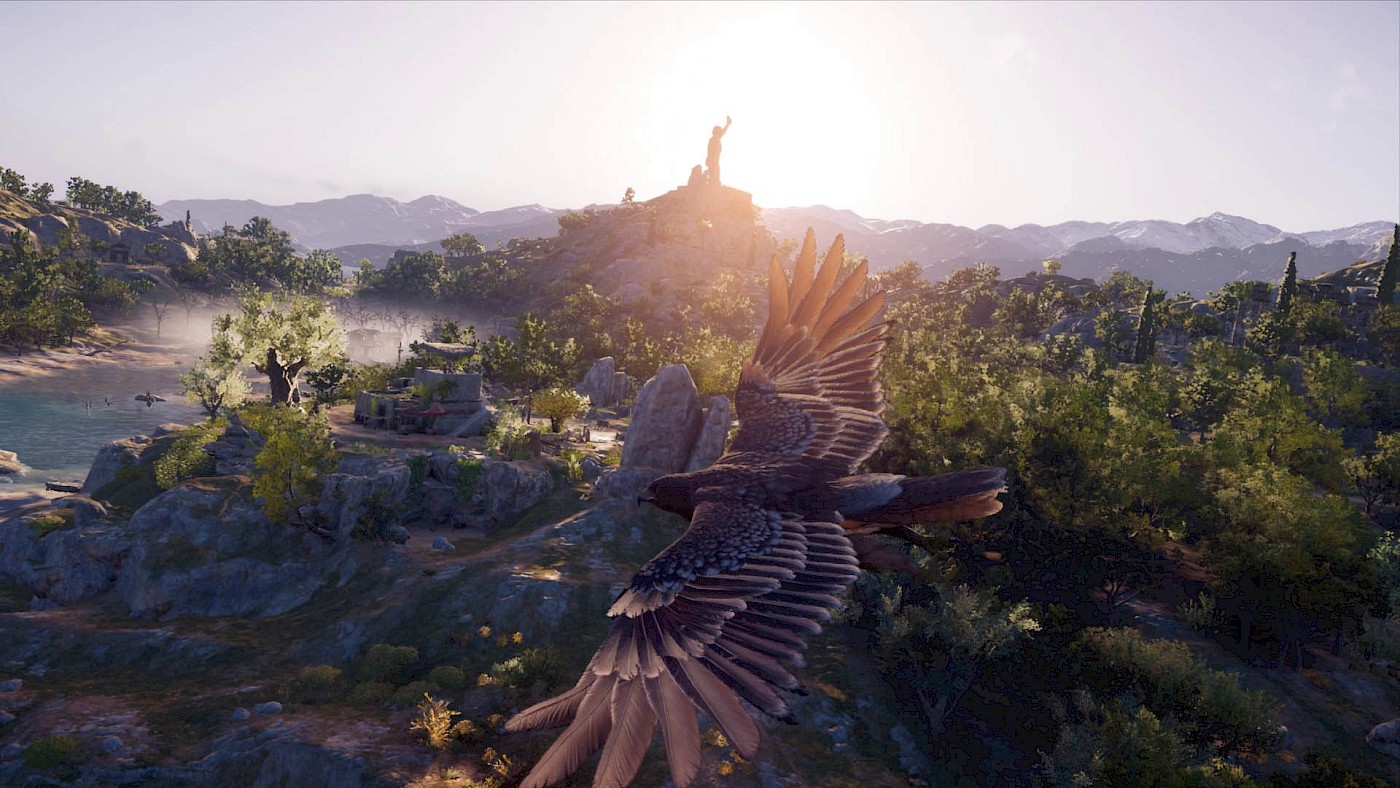As mentioned in the previous article, the game starts off on the island of Cephalonia (also sometimes referred to as Cephallonia, including in this game). Cephalonia is the sixth largest island in the waters around Greece, and part of the Ionian Islands group.
Cephalonia or Kephallenia was historically divided between four poleis or city-states: Kranioi (Krani), Samaioi (Sami), Palês (Pale), and Prônnoi (Pronni), as per Thucydides (2.30.2). In the game, you get the impression that the island only has one major town, Sami. This isn’t completely surprising: the developers have compressed the geography of Greece and limitations of space has precluded them from adding every settlement that ever existed to their map.
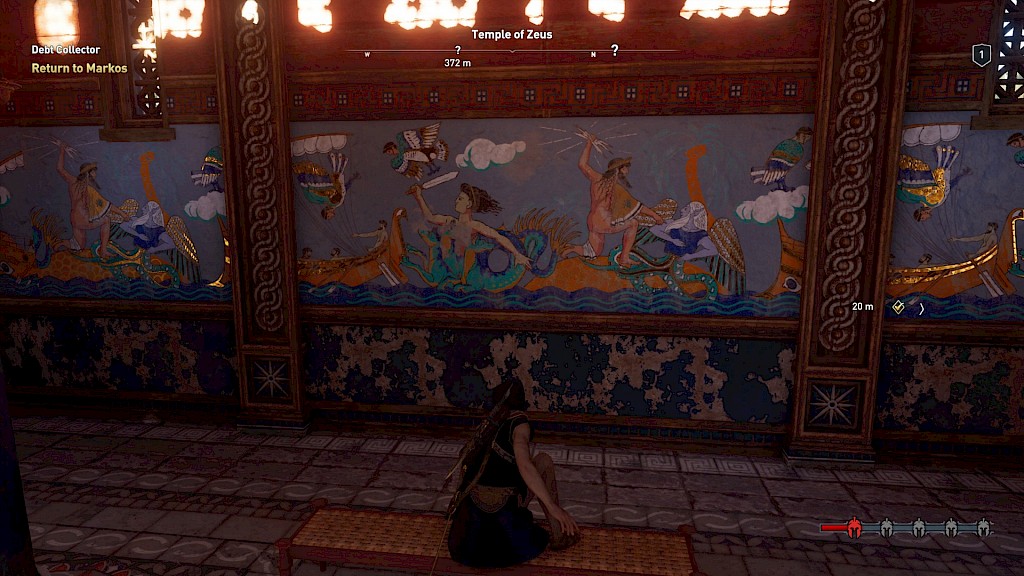
Still, what’s here makes a good first impression. As noted in the previous article, the game features many more buildings with flat roofs than is likely; most houses would have had sloping tiled or thatched roofs instead. But I like the general messiness of the structures: some buildings are damaged, others are under construction. Many feature painted walls or decorative elements: it all feels vibrant and alive. These are fun places to wander round in. I’ll write more about ancient Greek cities in the next article, after we’ve left Cephalonia and ventured to the mainland.
Temples and smaller shrines also appear to be everywhere, which fits the setting. The ancient Greeks were religious, as all ancient peoples tended to be. There’s some good variety here: I like the wooden temples in particular, as well as the smaller, simpler shrines, in addition to the stone structures. These religious buildings are all very colourful, with painted walls and decoration, both inside and out.
I also like the application of gold leaf, which rings true even if perhaps the scale on which it’s employed here is perhaps a little exaggerated. Indeed, one might object that perhaps the developers have made the temples a bit too colourful, but considering how often ancient architecture is presented as white it seems silly to complain about that.
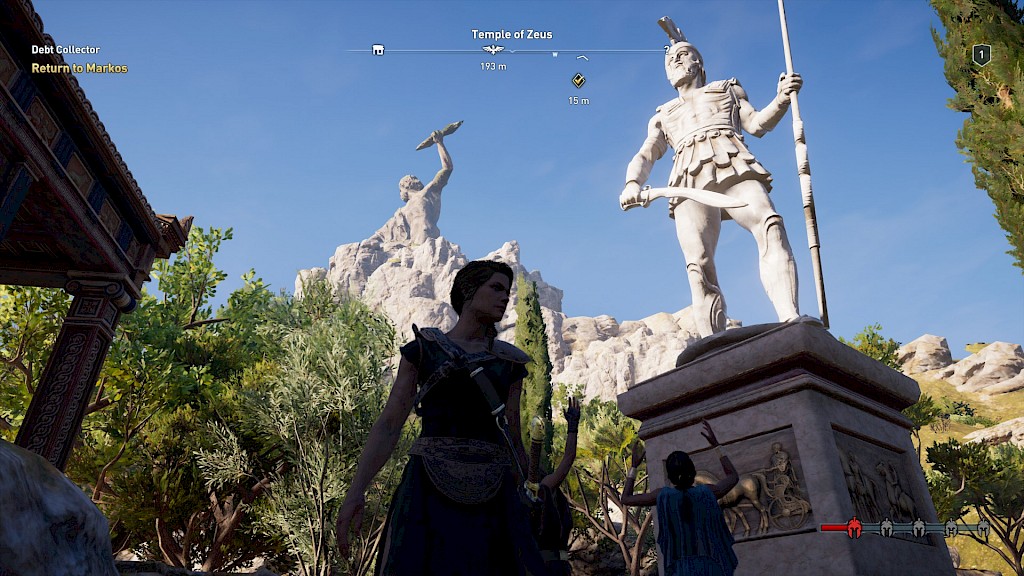
Weirdly, a lot of the stone statues that are found near temples and scattered around a few others places tend to be unpainted. In reality, ancient peoples painted their statues to make them seem as lifelike as possible. Almost none of the original surface of the stone would have been left visible. I’ve written about this topic in an earlier article.
Cephalonia also has a giant statue of Zeus that you can climb to obtain a better vantage point of the island and to “synchronize” the map. It’s ridiculously huge: such statues didn’t exist in ancient Greece and it’s taken directly from 2010’s Clash of the Titans. The developers do acknowledge their debt to popular media in the Art of Assassin’s Creed: Odyssey book (published by Titan Books), without directly referencing this film.
Mercenary service
After the initial brawl in front of the player character’s house, it’s time to meet Markos. Once you’ve reached him, he tells you that he spent your money on buying a vineyard. It’s quite a large estate and it must have cost a pretty penny. Clearly, business is booming for mercenaries on Cephalonia, even ones that apparently operate on their own as free agents. This begs the question: is this how mercenaries functioned in ancient Greece?
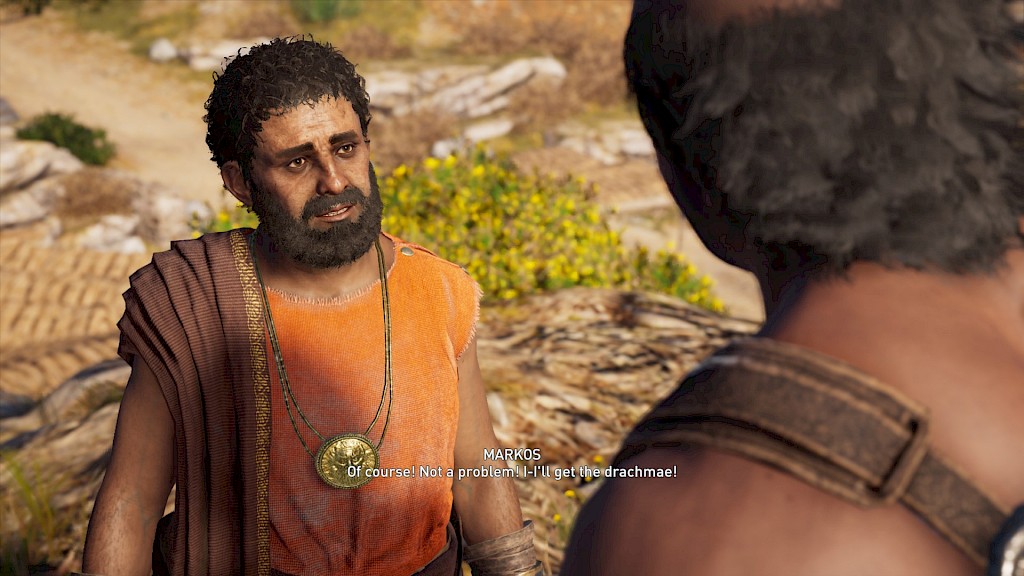
Usually, mercenaries were hired in times of war, and were paid only for the duration of the war or campaign in question. For the most part, mercenaries engaged for this purpose were hired en masse. They would have consisted of bands of men, usually headed by a leader who was presumably a man of some standing (e.g. an aristocrat). The leader would have been the one to forge the necessary ties, through friendship or diplomacy, to get himself and his followers hired for service.
Writing about such mass hirings, Matthew Trundle, in his book Greek Mercenaries: From the Late Archaic Period to Alexander (2004), notes that (p. 105):
It may not be stretching a point too far to see some mass mercenary hiring in the fifth and fourth centuries as harking back to the Homeric bands of retainers who followed individual and noble heroes to Troy. This goes far to explain why certain regions, namely Arcadia, Crete and Rhodes, figured so prominently in mercenary service.
The developers of the game clearly want the player character to possess the agency and free will of the ancient heroes of old, to come and go as (s)he pleases. And perhaps surprisingly, there’s some evidence that mercenaries could indeed operate on their own, hiring themselves out as individuals rather than as members of a larger group.
One example of such a freelancer is the Athenian Astyphilus. We know about him from one of the speeches written by Isaeus (no. 9), a famous Attic orator of the early fourth century BC, who mentions that Astyphilus went anywhere he heard that an army was being raised.
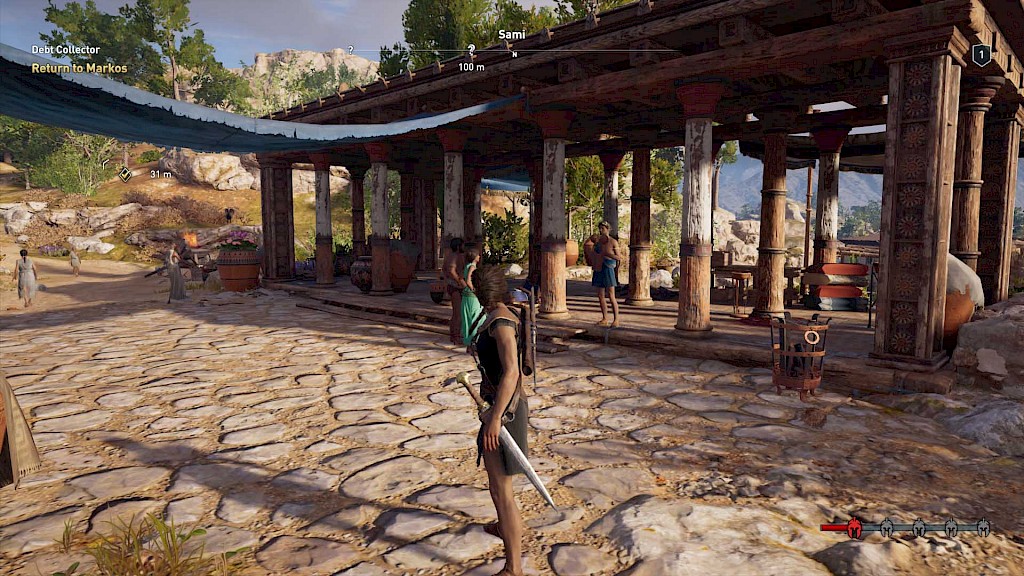
While engaging in combat would have been a risky proposition, there were also other, less hazardous duties available to mercenaries. Importantly, they could find gainful and often long-term employment as garrison troops (phrouroi) and bodyguards (doryphoroi or korynêphoroi), either in service of foreigners or other Greeks, from at least the sixth century BC onwards if not earlier (e.g. Thuc. 6.55.3; Xen. Anab. 1.7.2-4).
Quests on Cephalonia
The quests that you run through on Cephalonia mostly help you understand the game’s systems. Among other things, you’ll have to rescue Phoibe (which teaches you how to perform assassinations) and you need to decide how to go about completing a particular quest through dialogue choices (teaching you that some options allow for better outcomes than others). The quests in general flow fairly organically from one to the other, and add enough story and character elements to prevent them from feeling too simple.
The main quest line on the island sees you steal the eye of a bandit leader referred to as the Cyclops. The eye in question is made of obsidian and stored in his house: a large and fairly remote structure on the coast. This proves to be an excellent place to learn more about using your eagle as a spotter (to mark targets and located quest objectives) and to get a hang of the game’s stealth system. You also learn that you can distract the guards by, for example, releasing caged animals from their enclosures.
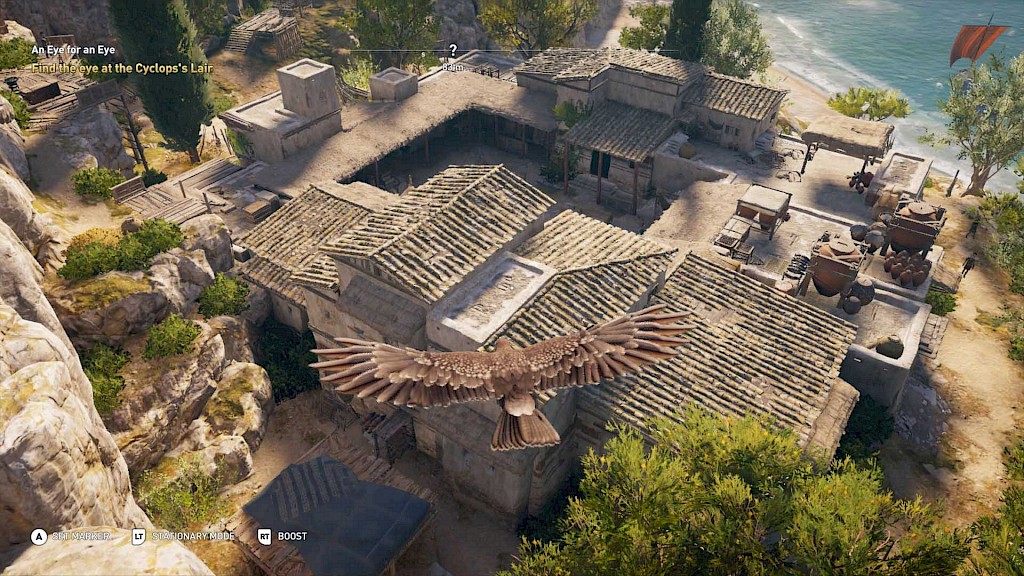
Eventually, you’re send out to kill a group of newcomers to the island. The final victim is dispatched by a man named Elpenor. This is one of those moments where the developers show that they’ve done their research: Elpenor is a character from Homer’s Odyssey, one of Odysseus’ men who is killed when, in a drunken stupor, he falls off the roof of a house he’s been sleeping on. The quest that this man sends you on sees you travelling to Ithaca to recover Penelope’s shroud from the ruins of Odysseus’ palace.
Ithaca is a small island right next to Cephalonia. You’re tasked with taking a small boat to this place: a clever way to introduce you to how the game handles seafaring, and something that will be expanded upon later. Regarding Ithaca, there’s actually been some debate over whether or not the island should be identified with Homer’s Ithaca. Some scholars have suggested that Cephalonia was originally Ithaca and the names were somehow transposed at an unknown point in the past.
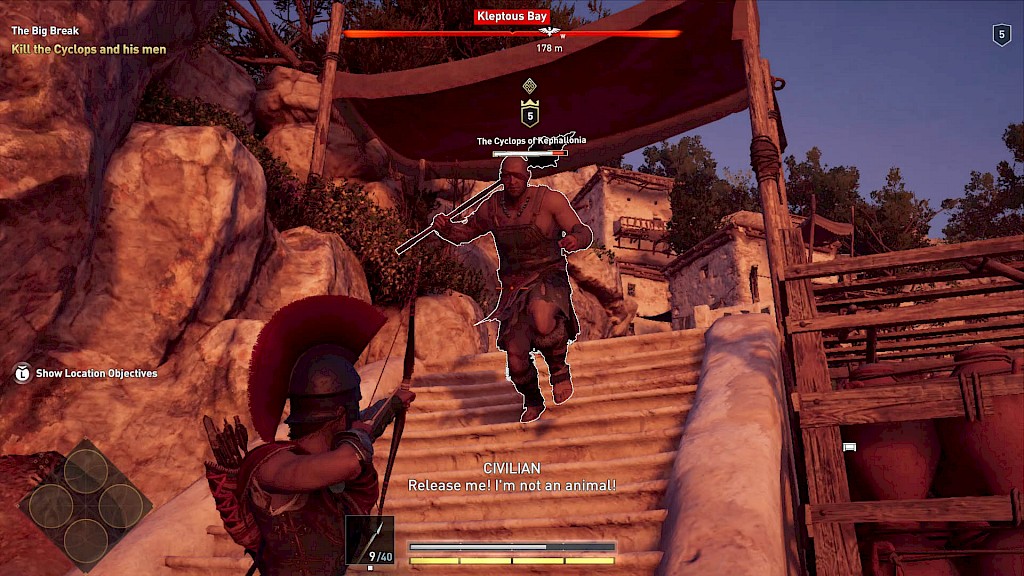
After completing your quest, Elpenor asks if you have a boat in order to head to Megara. You don’t and are then tasked to find one. A shipbuilder near Koliadai (another reference to Homer’s Odyssey) tells you that the Cyclops has one: kill the bandit and the ship is yours. This quest is the largest one yet and sees you infiltrate a large outpost, stalk (or simply attack) the Cyclops’ men, and eventually engage in a sort of boss battle against the Cyclops himself.
You’ll also free the captain of the ship, a man named Barnabas (a name that strikes me as a bit anachronistic, as it’s associated with the Christian era). You’ll need Barnabas and his ship to undertake the next task that Elpenor has given you, which is to sail to Megara – which the game insists is called “Megaris” for some reason – and kill a Spartan general nicknamed “The Wolf”. Barnabas reveals that the Wolf’s real name is Nikolaos.
And Nikolaos is your father.
